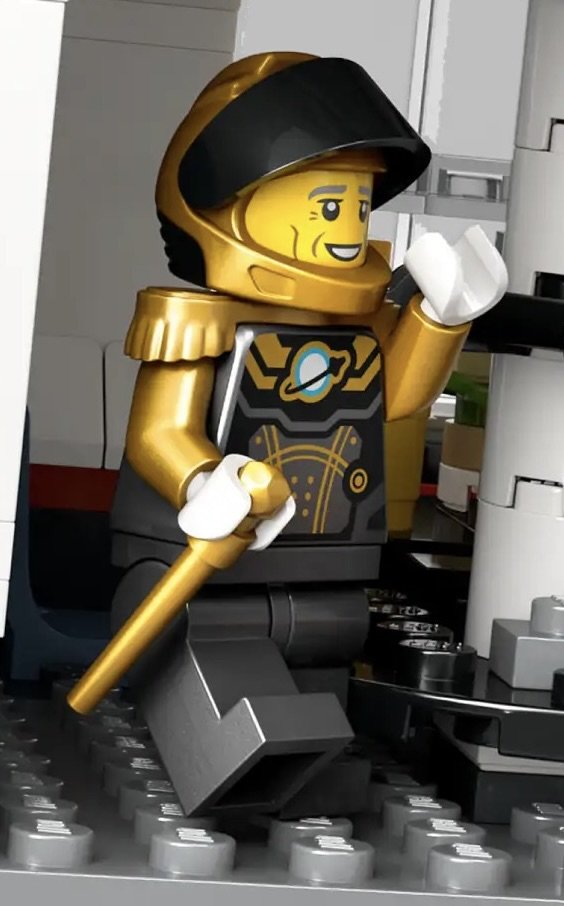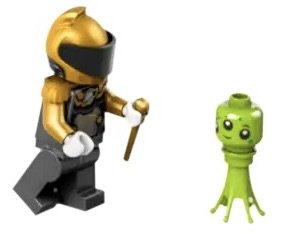Exploring the Cosmic Ensemble: A Comprehensive Exploration of LEGO City Space 2024 Minifigures and Their Intricate Design Narratives
After building several of the new space-themed LEGO City sets, I began noticing recurring patterns. All of the minifigs could be fairly consistently split into a handful of different factions or roles based on the designs of their suits.
Overall there seemed to be four main colors for the astronauts’ suits, blue, green, orange and black. There were also dark blue, dark green and dark orange, which all looked to fit similar roles to the lighter version of each color.
The 2024 space series riffs off of the classic space theme in some ways, like the design of the logo, so the different colored suits reminded me of the original classic space factions, which were never officially designated on the instructions or packaging but were later said by Jens Nygaard Knudsen, designer of the modern minifigure, to be distinguished by minifig spacesuit colors- explorers, scientists, technicians and warriors each had a different color uniform.(1)
In the current range of space sets, the most common color for the uniform is dark azure, a relatively newer color that has seen widespread use in the past several years. Judging by their lightweight equipment—accessories mainly consisting of holographic tablets (a piece regularly used across the theme as a detachable spaceship/rover control panel)—and their consistent appearance alongside vehicles in every set except the construction mech, it seems they serve as the pilots and drivers of the City space vehicle fleet.
Design ID: 58017
For helmets, they utilize the newer space helmet with a dual-molded panel on the back of the neck, along with the larger visors first introduced in the Atlantis theme. Their primary body gear includes the small dark azure jetpack, recolored from its initial introduction on First Order and Sith troopers in the Star Wars Episode IX sets. Two dark azure astronauts lack the distinctive jetpack, appearing in a 4+ set and a polybag with simplified designs.
#60430
The Interstellar Spaceship set (60430) features a pilot wearing dark blue with gold highlights who uses the same jetpack, helmet, and visor style as the dark azure astronauts. I interpret her as the leader or highest-ranking member of the dark azure pilot faction, a pattern that continues with other rarer, darker-uniformed astronauts wearing gold highlights. Additionally, she has a uniquely printed face, making her feel more special, akin to the named City characters from past set.
The second most common color scheme in the sets is bright green, featuring astronauts with slightly heavier gear designed for extravehicular use. This faction, characterized by bulky solar panel backpacks and scanners/cameras as accessories, seems tailored for explorers and researchers who spend the majority of their time outside their spacecraft and rovers. They don Nexo Knights helmets and classic motorcycle visors, while recolored LEGO City parachute backpacks provide additional space to attach solar panels and clips for the bulkier suits. A bright green astronaut without the backpack appears in the highly simplified 4+ set.
The dark green and gold-suited astronaut, similar to their counterpart in the pilot faction, appears to be a leader or commander for the explorer faction, donning the same style of uniform but with more intricate details. This includes an exclusive printed head with a built-in scope over one eye, reinforcing the idea that they are engaged in research and examination of whatever planet LEGO City is exploring. The dark green astronaut is featured in set #60433 Modular Space Station.
The third major uniform design for astronauts, and arguably the most distinct, is bright light orange, featuring much heavier gear on each minifig that I interpret as an engineering/mechanic faction. Their helmets are a completely new mold resembling a construction helmet with attachments for the classic motorcycle visor.
The front of the armor shows implied wear and tear, appropriate for a suit used in construction and repair work, in contrast to the other factions that look completely pristine. Overall, the armor brings to mind the space miner from series 12 of Collectible Minifigures.
The only astronaut officially designated to drive a vehicle outside of the pilot faction is one of the engineers, whose open-cockpit construction mech feels like a natural extension of their armored spacesuit. As for a leader, set 60434 Space Base and Rocket Launchpad introduces a minifig with identical armor and helmet designs, using dark orange with gold highlights. This leader even has a cybernetic arm with a detachable drill hand, adding to the heavy-duty appearance. His head features a unique grizzled print reminiscent of engineers in series like Power Miners, making him stand out prominently from the other astronauts.
The final and smallest 2024 space faction, and undoubtedly the most distinctive in terms of color scheme, is the black faction, represented by only one minifig in set 60434. While every other astronaut has a spacesuit base color of white with colored highlights, this character features a predominantly black suit with extensive gold highlights. Adorned with gold epaulettes and a cane, and being the sole occupant in the mission headquarters, he exudes the aura of an admiral or commander overseeing the entire mission.
His helmet is dual-molded in gold and black, using the same design as the pilots, and it features the only opaque visor in the theme—a black motorcycle visor that exudes an intimidating look. Although his head is not exclusive, it portrays the oldest appearance among all the crew, giving him the appearance of a weathered veteran of many space expeditions. While he may seem somewhat out of place among the rest of the minifigures, this can be attributed to his vastly different position and important rank compared to the others.
The inclusion of a commander in the 2024 set range is noteworthy for its continuity with the wide variety of 1990s space themes following classic space, where almost every theme featured a leader with special elements that visually set them apart from all other figures in their respective series.
While a few of the sets also include aliens, they align more with animal accessories than minifigures. Intentionally, these aliens don't correspond to any particular faction; instead, they serve as supplementary elements for the characters to encounter and discover during their missions. This approach is reminiscent of the animals in City jungle sets or the neon arachnid fossils in Town arctic sets.
It's worth noting that every 2024 space set contains a buildable robot, roughly minifig-size, designed to assist the human characters. This concept harks back to the common practice in many 1980s-90s space sets, especially those designed before robot minifigures became commonplace. The connection between robot color and role is weaker than with the minifigs, especially since the blue robots are largely unconnected to piloting duties. They are more geared towards exploration, akin to the single green robot. However, both robots with bright light orange highlights pair up nicely with their corresponding engineers, undertaking repair and excavation duties and showcasing hazard striping.
LEGO Rock Raiders 1999-2000
Across the entire range, the robots feature transparent purple batteries, matching the crystals the astronauts collect. This hints towards a storyline reminiscent of the 1990s Rock Raiders, where exotic crystals are mined on an alien planet as a power source.
Overall, the 2024 LEGO space minifigs are designed in a way that actively enhances the storytelling potential of the sets, providing significant value in my opinion. Each faction boasts a distinct style that aligns with a different role, yet maintains enough similarity to allow for flexible interpretations if desired. They don't overtly prescribe specific jobs for each minifig; instead, they embody the essence of relatively standard astronauts adaptable to various imaginative scenarios.
The subtle patterns within each color of uniform indicate additional thought put into minifig design concerning set design, a detail that is always appreciated. This becomes even more significant given the numerous similarities and callbacks to patterns found in beloved sets from the past.
The different colors that the original Space minifigures appeared in, were released over time. While there was no official story assigning roles to the different colors, according to Jens Nygaard Knudsen, "the red and white spacemen started as Cosmonauts and Astronauts. Later they became red pilots and white explorers, yellow were introduced as scientists, blue as security/soldiers, black as spies."(2)
Series 12 Space Miner






















